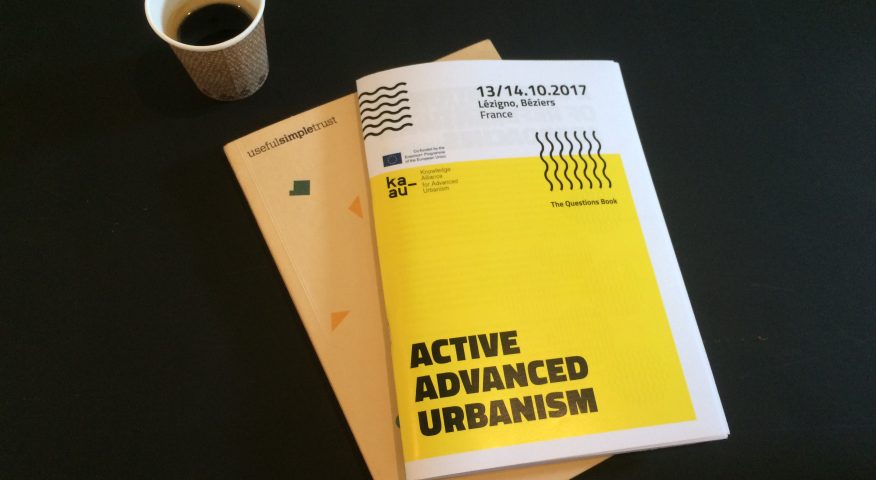What is Advanced Urbanism, and what do people involved in the design of the bulit environment need to know about it? This weekend I went down to the sophisticated manufacturing site of Technilium in Beziers, France to particiapate in a two day conference to answer these questions. The symposium is one of the activities of the Knowledge Alliance for Advanced Urbanism (KA-AU), an EU Erasamus+ funded initiative that aims to build research and collaboration between industry and academia on the topic of Advanced Urbanism.
At its inception, the KA-AU set out the following definition of Advanced Urbanism :
We understand “Advanced Urbanism” as the sensitive integration of ICT in cities. “Advanced Urbanism” is about merging technology and culture, focusing on planning processes –instead of just designing concrete artefacts, and engaging citizens, business and government into sustainable urbanism. “Advanced Urbanism” has a transdisciplinary nature. It requires changing traditional design and planning practices towards more open and collaborative practices.
The aim of the Beziers symposium, chaired by the team from the Università degli Studi di Genova (UNIGE), was to explore this definition and its consequences in more depth. The partners in the knowledge alliance all brought questions to the table to generate debate. The KA-AU will be producing a more thorough output from the session in due course but in the mean time, I’ve provided below my summary of key talking points that made me pause for thought. For more information, visit the KA-AU website.
We need a new way to regulate this new technological era
The internet is changing the way we interact with one another. What people are struggling to come to terms with is how to trust one another in a world in which the traditional borders and regulations aren’t effective any more. Technology defines the age in which we live. Society is really struggling to understand itself in the context of the new technology that it is using. The rules and regulations that govern our behaviour are for a previous technological era. What we need to do is develop the regulation for a new era.
The impact of Airbnb on cities is a good case study for this phenomenon. In Barcelona alone, 1,200 properties change status a week from being listed on AirBnB to being delisted from the site or vice-versa. That’s 1,200 properties a week whose status is changing. AirBnB is changing the function of buildings and areas of a city far faster than we can currently understand. The question is what is the most appropriate way to regulate this new world?
Technology changes. We should be asking what to save?
Advanced urbanism should have a critical view of new technology. We can’t celebrate it all, we need to filter what is most appropriate, and in doing so make sure we protect three things:
- the value of place
- the value of physical proximity
- the value of face-to-face contact.
Maybe urbanism has always been there to protect us from the worst excesses of technology. Don’t ask what we should change. Technology always changes things. What we should be asking is what we want to save?
Advanced urbanism is how people are living in technologically advanced cities
Advanced urbanism isn’t simply a new approach to urban design: it is how people are behaving in cities in which new technology is embedded and changing the way we live.Urbanism provides us with tools to manage society. In the past we used static masses (buildings), to organise cities. These took time to build and were experienced locally.
How has technology changed the way society is managed, or indeed manages itself? It moves us from static to dynamic organisation of people – people aren’t guided so much by massive objects but dynamic forces. We move from a slow-moving to an instantaneous timescale – how an area of a city might be used can change in a moment, as the AirBnB case study shows. And whereas our experience of the world was local, actions we take locally can now have a global impact.
The designer responding to this advanced urbanism needs to be able to deal with this dynamic, instantaneous and global world. For example, whereas in the past we may have designed an office block for people to work in, what people want now is places they can come together to work, but that location may change, and the function of the space may change, so the plans need to be much more adaptable.
Physical city structure reflects social structure
The physical structure of cities has reflected the social structure. For example in societies where the coming together in big crowds has been important, then those cities have had large open spaces. Other societies put less store in public gathering and have greater emphasis on the sanctity of the family, and in their cities we see homes with larger private courtyards where families can get together.
As technology changes our social structures, how will these changes manifest themselves in the way our cities are structured.
Only robots will be happy in smart cities.
If the aim of smart technology is to help us optimise the way we live, then we risk creating cities that only robots would like. Advanced Urbanism is about taking a more human view of how we use technology to plan and to live in the city.
No one is going to design cities from offices any more.
In a previous age, city planners sat down and planned how cities would be developed. Today the factors which shape the development of a city are much more dynamic and come from lots of different sources. Cities aren’t going to be designed any more from an office.

